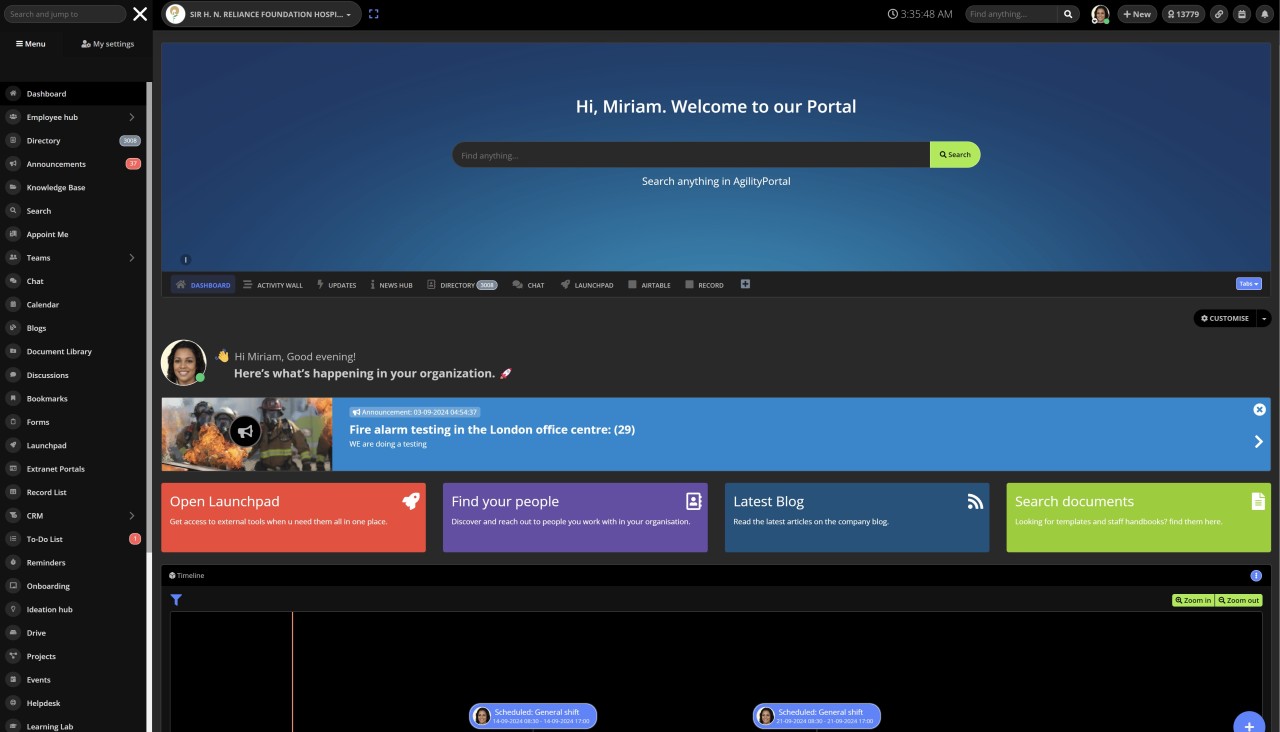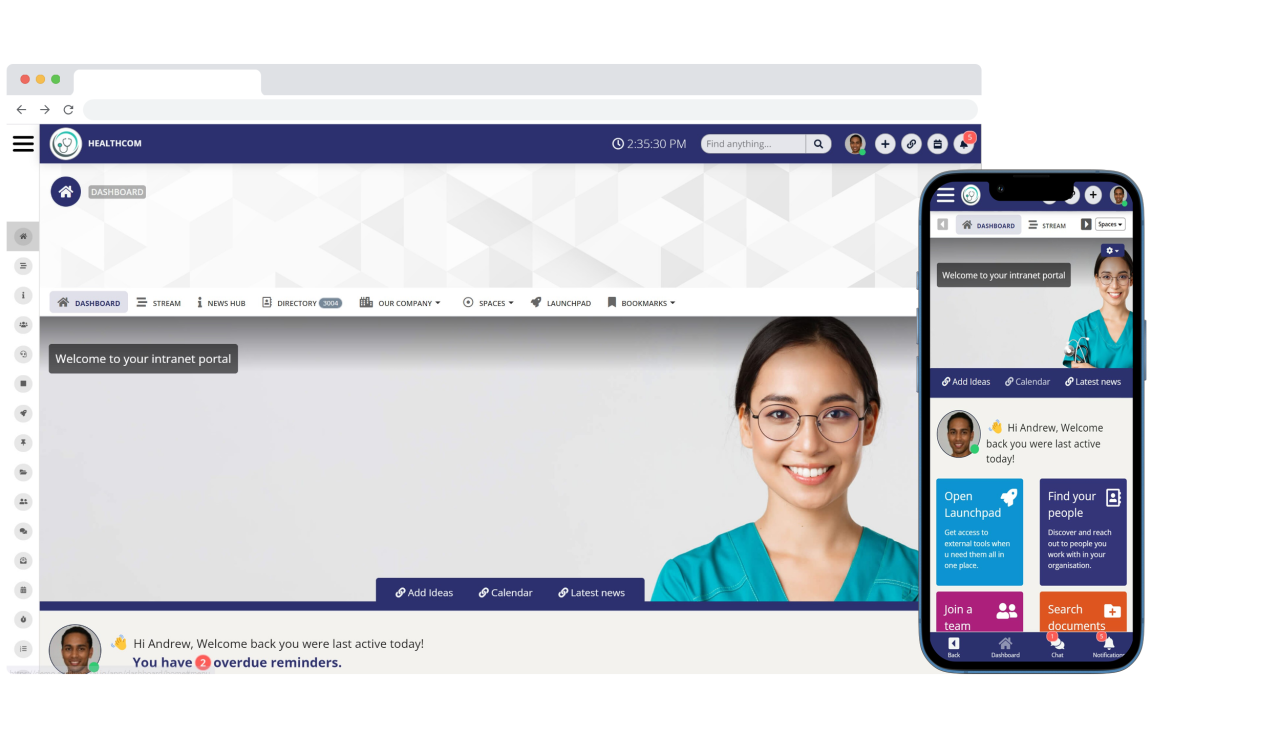Insight Blog
Agility’s perspectives on transforming the employee's experience throughout remote transformation using connected enterprise tools.
33 minutes reading time
(6539 words)
What Does a Communications Manager Do? A Comprehensive Guide
Discover what a Communications Manager does, from managing messaging strategies to ensuring clear, cohesive communication within an organization.
What does a Communications Manager do?
Effective communication is a vital skill in any business, and the role of a Communications Manager is central to ensuring that all internal and external messaging is clear and cohesive. While the title might not seem as urgent as other roles at first glance, hiring a Communications Manager early on is crucial.
They ensure smooth information flow between departments and leadership, fostering collaboration and preventing misunderstandings. This guide explores the essential duties of a Communications Manager, outlining how they manage communication strategies, streamline processes, and ultimately keep the organization connected and aligned.
What Exactly Is an Internal Communications Manager?
An Internal Communications Manager plays a critical role in ensuring that information flows smoothly within an organization. Their job is to oversee all internal messaging, acting as a bridge between different departments and leadership to ensure everyone stays informed and aligned.
Think of them as a traffic controller for communication—they manage what needs immediate attention, what can wait, and how best to convey essential updates. Whether it's delivering company-wide announcements, addressing employee concerns, or facilitating changes in communication channels, the Internal Communications Manager ensures that every team member is on the same page.
They help prevent bottlenecks, reduce confusion, and enhance transparency across the organization. In short, they are essential to maintaining internal harmony and keeping the team connected, no matter the size or complexity of the business.
Overview of an Internal Communications Manager
They ensure that an organization's internal stakeholders—employees, management, and executives—are well-informed, engaged, and aligned with the company's goals and values.
This position involves the strategic management of communication channels, fostering a positive work culture, and enhancing overall employee engagement. The role is vital for promoting organizational coherence and ensuring that every team member is on the same page regarding company objectives, policies, and updates.
Also, Internal Communications Managers are tasked with managing employee feedback mechanisms, such as surveys and suggestion boxes, to gauge the company's sentiment and identify improvement areas. They often collaborate closely with HR and executive teams to ensure that the communication strategies align with broader organizational goals and support initiatives like diversity and inclusion, employee well-being, and professional development.
Another critical aspect of the role involves organizing and managing internal events, such as town halls, leadership briefings, and internal events.
Key Responsibilities of a Communications Manager
As a Communications Manager, you will have the opportunity to grow and learn in a role that encompasses diverse responsibilities. You will be instrumental in ensuring effective and cohesive communication within and outside the organization. These include:
- Strategy Development: Formulate and execute comprehensive communication strategies and plans that align with the organization's goals.
- Content Creation: Generate and disseminate internal and external communications, such as press releases, newsletters, and official company statements.
- Media Relations Management: Handle media relations by responding to inquiries, organizing interviews, and preparing company representatives for public speaking.
- Media Monitoring: Track and analyze media coverage and industry trends to fine-tune communication strategies.
- Brand Consistency: Uphold brand guidelines, ensuring consistent messaging across all communication platforms.
- Digital Platform Management: Oversee the organization's website, social media accounts, and other digital communication platforms, ensuring timely and relevant updates.
- Content Development: Produce engaging content tailored for various channels, including blogs, articles, and speeches.
- Event Coordination: Plan and manage corporate events, conferences, and speaking engagements to enhance the organization's visibility and influence.
- Crisis Communication: Lead crisis communication efforts by developing strategies to manage and mitigate reputational risks.
- Cross-functional collaboration: Work closely with marketing, HR, and executive leadership to ensure communication efforts align with organizational objectives.
- Stakeholder Engagement: Build relationships with key stakeholders, including media outlets, industry influencers, and community organizations.
- Executive Support: Provide communication guidance to senior executives, including speechwriting and media training.
- Market Research: Conduct research and market analysis to identify communication opportunities and effectively target audiences.
- Online Reputation Management: Monitor and manage the organization's online reputation, promptly addressing customer feedback and reviews.
- Continuous Improvement: Your role will require you to stay updated with industry trends, best practices, and emerging technologies, fostering a culture of continuous improvement in our communication strategies and tactics.
Top Industries for Communications Managers
In the United States, the highest concentration of Communications Manager positions is in the Advertising, Public Relations, and Related Services sector, which accounted for approximately 10.9% of all roles in 2022.
Other leading industries by employment percentage include Management of Companies and Enterprises (8.9%), Business, Professional, Labor, Political, and Similar Organizations (8.1%), Colleges, Universities, and Professional Schools (5.4%), State Government Education and Hospitals (4.9%), and Local Government, excluding Education and Hospitals (4.5%).How to become a communications manager
Becoming a Communications Manager involves a blend of education, experience, and skill development. Aspiring candidates typically need a solid educational foundation for this career path. A bachelor's degree in communications, public relations, journalism, marketing, or a related field is usually the minimum requirement. These programs provide essential knowledge in media, writing, public speaking, and strategic communication—critical areas for anyone aiming to understand how to become a communications manager.
Equally important to formal education is the acquisition of relevant experience. Entry-level roles such as communications assistant, public relations specialist, or content creator provide invaluable hands-on experience.These positions help you build a portfolio, hone your writing and communication skills, and learn the ropes of media relations and internal communications. Internships, whether during or after academic studies, are also a significant avenue for gaining practical insights and industry connections.
Skill development is another critical step in becoming a Communications Manager. Strong writing and editing skills are fundamental, as the role often involves crafting press releases, internal newsletters, and other communications.
Skill development is another critical step in becoming a Communications Manager. Strong writing and editing skills are fundamental, as the role often involves crafting press releases, internal newsletters, and other communications.
Additionally, proficiency in digital tools like content management systems, social media platforms, and analytics software is increasingly essential in today's digital-first communication landscape. Soft skills such as leadership, strategic thinking, and crisis management are also necessary, as Communications Managers often lead teams and make decisions that impact an organization's reputation.
Finally, the journey to becoming a Communications Manager is not a solitary one. Networking and continuous learning are pivotal in career advancement. Joining professional organizations, attending industry conferences, and pursuing certifications are effective ways to stay abreast of the latest trends and expand your professional network.
Finally, the journey to becoming a Communications Manager is not a solitary one. Networking and continuous learning are pivotal in career advancement. Joining professional organizations, attending industry conferences, and pursuing certifications are effective ways to stay abreast of the latest trends and expand your professional network.
By integrating education, experience, skills, and networking, you can successfully navigate the path to becoming a Communications Manager.
An Internal Communications Manager's First Tasks
Upon joining an organization, an Internal Communications Manager's initial tasks are crucial for setting the stage for effective internal communication. Their first responsibility is to assess the current communication landscape and identify areas of improvement.
#1.Communications Channels Optimization
After mapping out the existing communication channels, the next step is optimizing them for better efficiency. The Internal Communications Manager identifies which channels are underused, overused, or causing confusion. They may also recognize outdated methods that no longer serve the company's needs.
Their job is to streamline communication by suggesting alternatives, combining redundant platforms, and establishing a clear hierarchy for information flow. This ensures that employees can access the right information quickly and without confusion.
Optimizing communication channels is crucial to creating a seamless flow of information that helps employees stay engaged and productive, without being overwhelmed by irrelevant content.
#2.Mapping All Communications
The first task for a new Internal Communications Manager is to thoroughly map out all internal communication channels.
This involves analyzing how information is currently shared across the organization, from top-level management to individual employees. The goal is to understand which channels are most frequently used, where communication bottlenecks exist, and how information is distributed. This step helps them gain insight into the flow of information, its effectiveness, and potential areas for improvement.
With this communication map, they can propose necessary adjustments and ensure that all employees receive relevant updates without being overwhelmed by unnecessary details.
#3.Using Tech Tools to Support the Internal Communication
In today's digital world, technology plays a key role in effective communication. One of the major tasks of an Internal Communications Manager is evaluating the current tech tools in use and determining if they are adequately serving the organization. They assess whether these tools are being fully utilized, if they need upgrading, or if the company requires new solutions entirely.
For example, they may recommend using unified platforms, mobile apps, or cloud-based services to reach employees who aren't always at their desks.
The goal is to simplify communication and make it accessible to everyone, regardless of location or role. Using the right tools can greatly enhance how teams collaborate, share information, and stay connected.
#4.Backup Plan for the Communication Channels
The Internal Communications Manager must also create a backup plan in case any communication channel becomes unavailable. This could happen during technical failures, emergencies, or periods of high traffic.
They need to determine how communication will continue in such cases—whether it's by redirecting messages to alternative platforms or setting up secondary channels that can handle the load.
The goal is to ensure that important information reaches everyone, no matter the situation. A solid backup plan ensures that the organization remains functional even when faced with disruptions, keeping communication steady and reliable under all circumstances.
#5.Plans for Emergency Communication
Handling communication during a crisis is one of the most sensitive and important tasks for an Internal Communications Manager. They are responsible for creating a structured plan to address emergencies, such as major incidents or unexpected events that could disrupt normal operations.
This plan includes identifying which channels will be used, how quickly updates need to be shared, and who will oversee the communication.
Clarity and speed are essential during emergencies, and having a predefined plan ensures that everyone knows their role, preventing panic or confusion. A well-prepared emergency communication strategy helps the organization respond effectively and maintain trust with employees.
#6.Employee Engagement
One of the Internal Communications Manager's most important roles is fostering employee engagement. Keeping employees informed and connected to the organization's goals and values is crucial to maintaining morale and productivity. This means ensuring that employees are aware of key developments, achievements, and news within the company.
They also work to create a culture where employees feel their voices are heard and valued. Whether it's through company newsletters, updates, or recognition of achievements, the goal is to make employees feel invested in the organization's success. An engaged workforce is more motivated and aligned with the company's objectives.
#7.Internal Communication Supportive Procedures
Establishing clear procedures to support internal communication is a vital responsibility. This involves creating guidelines for how different types of information are handled and reported. For instance, procedures must be in place for employees to report issues like theft or harassment, and there should be channels dedicated to these sensitive matters.
The Internal Communications Manager ensures these procedures are not only developed but also communicated to the entire workforce. By setting clear protocols, employees know exactly how and where to seek support, which fosters transparency and trust within the organization.
An Internal Communications Manager's Daily Routine
Once settled into their role, an Internal Communications Manager's daily tasks revolve around maintaining and improving the organization's internal communication. Their role requires constant monitoring, adapting, and engaging with the organization to ensure information flows smoothly.
#1.Adjusting To The Organization
A key part of an Internal Communications Manager's routine is staying informed about the company's structure and any ongoing changes. They must be deeply familiar with every department, team, and process to make informed decisions about communication strategies. This involves tracking organizational developments and staying connected with managers to ensure that communication aligns with current needs.
As new branches open, teams expand, or processes evolve, the Internal Communications Manager must adapt internal communication accordingly. Their understanding of the organization is crucial to ensuring that all employees receive relevant and timely updates without being overwhelmed by unnecessary information.
#2.Taking Part
The Internal Communications Manager is often involved in company-wide initiatives, ensuring that communication supports and promotes these efforts. They attend manager meetings, assist with organizational projects, and help implement strategic decisions.
Whether the company is going through rebranding, launching new services, or handling mergers, they ensure that internal messages are clear and consistent.
Being involved at all levels of decision-making ensures that they can anticipate communication needs and prepare appropriate strategies. Their role is integral to keeping employees informed and aligned with broader organizational goals.
#3.Emergency Response
A critical part of an Internal Communications Manager's role is responding to emergencies. When unexpected events such as crises or internal issues arise, they must act swiftly to ensure that clear and accurate information is communicated to all employees.
This involves coordinating with management to develop the appropriate messaging and ensuring that it reaches everyone through the right channels.
During such times, their role is essential in preventing panic, confusion, or misinformation. By having pre-planned emergency communication protocols in place, they ensure that the organization can respond quickly and effectively to any crisis, keeping all stakeholders informed and calm.
#4.Looking For Communication Slips and Failures
The Internal Communications Manager constantly monitors for breakdowns or inefficiencies in communication. Whether it's a missed message, an overloaded channel, or employees being left out of the loop, they need to identify and resolve issues quickly. They analyze feedback, observe how communication flows through the organization, and listen to employee concerns.
If a particular process is causing confusion or if information isn't reaching the intended audience, the manager steps in to fix the problem. Their goal is to streamline communication channels and ensure that every employee can easily access the information they need to perform their tasks efficiently.
How Do We Know If The Internal Communication Manager Did A Good Job?
Evaluating the effectiveness of an Internal Communications Manager involves assessing the impact from various perspectives within the organization. Each department or role views success differently, making it crucial to consider multiple viewpoints.
From The CEO's Point Of View
For the CEO, the main concern is whether the Internal Communications Manager can ensure that information reaches all employees quickly and accurately, especially during critical moments. If the CEO's decisions, updates, or crisis management instructions are communicated without delay or misinterpretation, then the manager has done their job well.
Additionally, the CEO will look for evidence that communication tools and strategies have enhanced overall efficiency, reduced miscommunication, and helped create a more transparent work environment. The ability to maintain seamless communication even during high-pressure situations is a key indicator of success from the CEO's perspective.
From Management's Point Of View
From the perspective of management, the Internal Communications Manager's effectiveness is measured by how easily they can relay information to their teams.
Managers rely on communication channels to convey goals, updates, and expectations to employees. If these messages are delivered efficiently and without disruption, it demonstrates that the Internal Communications Manager has implemented strong, reliable communication processes.
Additionally, managers will assess whether their communication needs are being met, particularly regarding the distribution of critical information during projects or changes within the company. A well-functioning communication system ensures smooth collaboration across departments.
From The Employee's Point Of View
Employees expect clear, timely communication about what is happening within the company, particularly concerning changes that affect their roles. If employees feel informed about company updates, new policies, or changes in management, they will perceive the Internal Communications Manager as doing a good job.
Employees also appreciate having accessible platforms where they can find answers to their questions or express concerns.
A well-managed communication system fosters a sense of engagement and belonging, making employees feel valued and involved in the organization's mission and goals. When communication flows seamlessly, employees can focus on their tasks without confusion or delays.
From HR's Point Of View
The HR department values communication that enhances employee engagement and supports company culture. For HR, a successful Internal Communications Manager is one who keeps employees connected with company values, achievements, and benefits.
This could be through sharing updates on employee recognition programs, promoting wellness initiatives, or keeping the workforce informed about company policies.
Additionally, HR will assess how well the communication channels handle sensitive issues, such as performance feedback or conflict resolution. If the communication manager effectively aids HR in creating a cohesive work environment, they are considered to be doing a great job.
From The Marketing Department's Point Of View
For the marketing department, internal communication is crucial in aligning employees with external branding and promotional efforts. A successful Internal Communications Manager ensures that all employees are aware of ongoing marketing campaigns and how they contribute to the company's image.
If employees are actively engaged with the company's marketing goals—whether through brainstorming sessions, feedback, or simply sharing marketing content—then the communication manager has succeeded.
Additionally, clear and efficient communication helps marketing teams coordinate internally and externally, ensuring that everyone is on the same page when launching campaigns or addressing customer feedback.
Internal Communications Manager Practical Tips and Recommendations
An Internal Communications Manager plays a pivotal role in shaping how information flows within an organization, directly impacting employee engagement, morale, and overall organizational effectiveness.
To excel in this role, it's essential to develop robust communication strategies and implement practical steps that ensure these strategies are effective and well-received by employees. Below are some actionable tips and preventive measures that Internal Communications Managers can use to enhance their communication efforts, mitigate potential challenges, and maximize positive outcomes within their organizations.
- Establish Clear Communication Channels: Ensure that employees know where to find information and who to contact for various types of inquiries. Create a centralized platform, such as an intranet or internal newsletter, where all updates, announcements, and resources are easily accessible.
- Craft Targeted Messages: Tailor your communications to different employee groups based on their roles, departments, and information needs. This approach ensures that your messages are relevant and resonate with your audience. Use segmentation tools to deliver specific content to the right people at the right time.
- Foster Two-Way Communication: Encourage feedback and dialogue by setting up channels where employees can voice their opinions, ask questions, and provide suggestions. Regularly check in with employees through surveys or pulse checks to understand their concerns and adjust communication strategies accordingly.
- Leverage Visual and Multimedia Content: Use visuals, videos, and infographics to make your messages more engaging and easier to digest. Incorporating different formats can help convey complex information more effectively and maintain employee interest.
- Anticipate and Address Employee Concerns: Before rolling out significant changes or announcements, consider the potential concerns employees might have. Prepare Q&A documents, provide context, and offer clear explanations to minimize uncertainty and confusion.
- Monitor Communication Effectiveness: Regularly assess the effectiveness of your internal communications by tracking engagement metrics such as email open rates, intranet traffic, and survey participation. Use this data to identify areas for improvement and adjust your strategies accordingly.
- Maintain Consistency: Ensure that messaging is consistent across all platforms and from all leaders. Mixed messages can create confusion and erode trust. Develop and follow a style guide that outlines tone, terminology, and messaging guidelines to maintain consistency.
- Prepare for Crisis Communication: Develop a crisis communication plan that outlines procedures for quickly and effectively disseminating information during emergencies. Train leaders and employees on the plan to ensure swift, coordinated action when needed.
- Highlight Success Stories: Regularly share employee success stories, departmental achievements, and company milestones to boost morale and reinforce a positive workplace culture. Celebrating wins fosters a sense of community and motivates employees.
- Incorporate Recognition and Rewards: Acknowledge and reward employees who contribute to the organization's success. Public recognition, even in internal communications, can motivate others and enhance overall engagement.
- Stay Adaptable: Internal communication needs can change rapidly, especially in dynamic environments. Stay flexible and be ready to adjust your strategies to address evolving employee needs and organizational goals.
Challenges Faced by Internal Communications Managers
Internal Communications Managers often need help to ensure message consistency across a diverse and distributed workforce.
Maintaining a unified message becomes complex in large organizations, where employees may be spread across various locations, departments, or even countries. Differences in language, culture, and communication preferences can lead to misinterpretations or diluted messaging. The challenge is to craft messages that resonate equally with all employees, regardless of their role or location, while ensuring that the core message remains consistent and clear across all communication channels.
Another significant challenge is fostering engagement and participation among employees.In many organizations, internal communications can be perceived as top-down directives, leading to disengagement or apathy from employees who feel their voices are not heard.
Encouraging two-way communication is critical, but it requires overcoming barriers such as fear of speaking up, lack of trust, or simply a lack of time among employees to engage with internal communication efforts. Internal Communications Managers must continuously innovate to create more interactive and inclusive communication strategies that encourage employee input and feedback.
Lastly, the rapid pace of change in today's work environment poses a constant challenge for Internal Communications Managers. Whether it's navigating organizational restructuring, adapting to new technologies, or responding to external crises, these managers must be agile and responsive.
Lastly, the rapid pace of change in today's work environment poses a constant challenge for Internal Communications Managers. Whether it's navigating organizational restructuring, adapting to new technologies, or responding to external crises, these managers must be agile and responsive.
The need to communicate swiftly and effectively during periods of change can be daunting, as the risk of misinformation or panic among employees is high. Balancing the need for timely updates with the necessity of providing accurate and thoughtful information is a weighty responsibility, requiring careful planning and a deep understanding of the organization's dynamics.
4 Common Workplace Communication Problems & How to Fix Them
Effective communication is the backbone of any successful organization.
However, many workplaces struggle with communication issues that can hinder productivity, create misunderstandings, and affect employee morale. Identifying these common communication problems and implementing strategies to address them is crucial for fostering a positive and efficient work environment.
Here are some of the most prevalent workplace communication problems and how to fix them.
Problem #1: Communication barriers
Communication barriers come in various forms, each creating obstacles that hinder the flow of information within an organization. These barriers include:
- Physical boundaries, such as remote or field teams being geographically dispersed.
- Varying work schedules among colleagues can lead to missed opportunities for communication.
- A lack of effective communication channels or tools to facilitate interaction.
- Language or cultural differences can cause misunderstandings and misinterpretations.
These barriers can significantly impact employees' ability to collaborate, share ideas, and maintain alignment with organizational goals. As a result, productivity may decline, employee morale can suffer, and the overall business performance might be negatively affected.
Solution: Leverage Employee Communication Tools
To effectively overcome these communication barriers, investing in a robust internal communication platform like AgilityPortal is crucial. AgilityPortal offers features to support instant, transparent, and effective communication across your organization, regardless of physical or operational challenges.
Remote and field teams can stay connected through seamless communication tools that transcend physical boundaries. The platform supports 1:1 and group chat features, enabling instant communication and collaboration regardless of employees' locations or schedules. This helps ensure all team members are on the same page and can easily share ideas and updates.
Those tools also address scheduling conflicts by providing an organized and accessible platform where employees can communicate asynchronously, catching up on important messages or updates at their convenience. This flexibility helps bridge the gap between working hours and time zones, fostering a more inclusive and cohesive work environment.
It has features, such as an in-app employee directory and cross-company social feed, that promote transparency and inclusivity, making it easier for employees to stay informed and feel connected to the company. These tools are precious in overcoming language and cultural barriers, as they provide clear, written communication that can be easily translated or understood.
By implementing communication tool, you empower your team with the tools they need to communicate effectively, collaborate seamlessly, and stay aligned with organizational goals. This ultimately leads to improved productivity, stronger team relationships, and a more positive impact on your bottom line. Here is how to become a culture champions at work – A Complete Guide
Problem #2: Lack of Feedback
Employees who don't receive regular performance feedback can feel isolated, undervalued, and disengaged. Waiting an entire year for an annual performance review leaves staff in the dark about their progress, leading to repeated mistakes, frustration, poor morale, and, ultimately, increased employee turnover. Without timely feedback, employees miss valuable opportunities for development and growth, negatively impacting their overall performance and job satisfaction.
Solution: Use a Feedback or Survey tools
Instead of relying solely on annual performance reviews, providing employees with regular, consistent feedback is essential. AgilityPortal offers tools that make it easier to give both positive and constructive feedback on a weekly or monthly basis, ensuring that employees are always aware of how they're performing.
Tools with feedback features allow managers to deliver timely, specific, and objective assessments directly through the platform, facilitating ongoing dialogue between supervisors and their teams. These regular check-ins are a chance to review performance and discuss priorities, set new goals, and ensure that employees have the necessary resources, time, and information to excel in their roles.
The platform's structured feedback system helps employees understand their strengths and areas for improvement, keeping them engaged and motivated. By providing continuous feedback, you create a work environment where employees feel valued and supported, significantly boosting morale and reducing turnover rates by up to 30%.
It is very important to understand that feedback becomes an integrated part of your company culture, fostering employee development and helping to build a more positive, productive, and satisfied workforce.
Problem #3: One-Way Communication
When communication only flows in one direction—where management talks and employees listen without a chance to share their thoughts—staff can quickly feel disconnected, undervalued, and demotivated. This lack of interaction can severely impact employee productivity, retention rates, and overall company culture. Furthermore, one-way communication often leads to misunderstandings and errors, as employees may not fully grasp the information shared or have the opportunity to ask for clarification. This can result in delays, mistakes, and even accidents.
Solution: Foster Open Communication
To combat the issues of one-way communication, it's essential to build a two-way communication relationship with your team. AgilityPortal provides the tools necessary to create a more interactive and inclusive communication environment. Through features like regular check-ins, feedback sessions, and employee surveys, managers can actively engage with their teams, encouraging them to share their thoughts and concerns openly.
AgilityPortal allows you to facilitate these dialogues seamlessly, ensuring that communication is not just top-down but also bottom-up. Managers can use the platform to listen to employee feedback, respond to their concerns, and take appropriate action where necessary. This approach fosters a culture of transparency and trust, where employees feel comfortable expressing their ideas, asking questions, and making suggestions.
Moreover, implementing an open-door policy through AgilityPortal can enhance accessibility as a manager, encouraging a continuous flow of communication. This not only helps in gaining quick access to critical information but also in maintaining closer working relationships with employees. Research shows that such practices can lead to a more engaged workforce, where employees are more likely to feel valued and motivated, thereby improving overall productivity and retention rates.
By utilizing AgilityPortal to encourage open communication, you can create a work environment that values employee input, reduces misunderstandings, and fosters a culture of collaboration and trust.
Problem #4: Poor Knowledge-Sharing
When departments, teams, or even individual employees work in silos, they often fail to share information, leading to inefficiencies, duplication of work, and missed opportunities for collaboration.
This lack of knowledge-sharing can also result in errors due to incomplete or outdated information. Furthermore, when company knowledge is scattered across various locations or stored in multiple formats, it becomes difficult for employees to quickly find and access the information they need. This can lead to frustration, wasted time, and mistakes, as employees may inadvertently rely on outdated or incorrect materials.
Solution: Provide a Knowledge Sharing, using a KB application
To address poor knowledge-sharing in the workplace, it's essential to foster a culture that encourages collaboration and makes company knowledge easily accessible to everyone. AgilityPortal offers a comprehensive internal communication and knowledge management system that centralizes all company information in one easy-to-access location.
With AgilityPortal, your employees can quickly find the resources they need, connect with the right people, and share knowledge across departments and teams with just a few clicks. The platform allows you to store company knowledge in a structured and organized manner, ensuring that all information is up-to-date and accessible to everyone in your organization, no matter where they are working from.
By implementing knowledge base tool, you can break down the silos that hinder knowledge-sharing and create a more collaborative and efficient work environment. Employees will spend less time searching for information and more time utilizing the correct resources, leading to fewer mistakes, improved productivity, and greater job satisfaction.
AgilityPortal not only streamlines communication and collaboration but also empowers your workforce by providing them with the tools they need to succeed. This ensures that knowledge flows freely throughout your organization, driving innovation and helping your company achieve its goals.
Tools Used by Internal Communications Managers
Internal Communications Managers rely on various tools to facilitate effective organisational communication.
These tools are essential for managing the flow of information, ensuring that employees are well-informed, and fostering a sense of community and engagement across the workforce. The choice of tools often depends on the organization's size, structure, and specific communication needs, but several categories of tools are universally crucial for anyone in this role.
- Content management systems (CMS) play a pivotal role in the work of Internal Communications Managers. These platforms serve as a centralized hub for creating, editing, and distributing content across various internal channels. Whether it's crafting newsletters, updating the intranet, or managing an internal blog, CMS provides a single location for managing all written and visual communications. They also include features for scheduling posts, tracking engagement, and ensuring that content is consistently aligned with the organization's messaging and branding guidelines.
- Collaboration and project management tools are indispensable for Internal Communications Managers. These tools facilitate seamless communication and coordination among team members, particularly in organizations with large, distributed teams. They assist managers in organizing tasks, setting deadlines, and monitoring progress, thereby ensuring that all communication projects are completed on time and meet the required standards. These tools often include features for file sharing, real-time chat, and document collaboration, making it easier for teams to work together, regardless of their physical location.
- Employee feedback and survey platforms are other essential tools for Internal Communications Managers. These platforms are crucial for gauging employee sentiment and gathering insights on how communication strategies are being received. They allow managers to create and distribute polls, surveys, and feedback forms to employees, providing valuable data on engagement levels, communication effectiveness, and areas needing improvement. These tools often offer analytics capabilities, helping managers interpret the data and adjust their strategies accordingly.
- Social intranets and internal social networks like AgilityPortal are increasingly popular in facilitating organisational communication and collaboration. These platforms function as digital workplaces where employees can interact, share updates, and collaborate on projects. Internal Communications Managers use these tools to post announcements, create discussion forums, and encourage employee social interaction. By fostering a sense of community, these tools help to strengthen employee engagement and create a more cohesive organizational culture.
- Instant messaging and communication apps are indispensable for enabling real-time organisational communication. These tools allow quick, direct communication between employees, teams, and departments, facilitating rapid information exchange and decision-making. Internal Communications Managers use these platforms to send urgent updates, coordinate with other departments, and ensure that information flows smoothly across the organization.
- Crisis communication tools are critical for Internal Communications Managers, particularly during organizational upheaval or external crises. These tools are designed to disseminate information quickly and efficiently during emergencies, ensuring that all employees receive timely and accurate updates. They often include features for mass messaging, emergency alerts, and communication tracking, helping managers coordinate their response and keep everyone informed.
- Analytics and reporting tools are essential for measuring the effectiveness of internal communication efforts. These tools allow Internal Communications Managers to track key performance indicators (KPIs) such as message open rates, employee engagement levels, and feedback scores. By analyzing this data, managers can identify what's working, what needs improvement, and how to optimize future communications for better results.
- Lastly, video conferencing and webinar platforms are increasingly important in today's remote and hybrid work environments. These tools enable face-to-face communication, crucial for maintaining a personal connection with employees, especially when working remotely. Internal Communications Managers use these platforms to host virtual town halls, training sessions, and other events that require visual and interactive engagement.
So basically, Internal Communications Managers use diverse tools to manage and enhance communication within their organizations. From content management systems and collaboration tools to feedback platforms and analytics software, these tools are essential for ensuring that internal communications are effective, engaging, and aligned with organizational goals.
Frequently Asked Questions
What Does a Communications Manager Do
A Communications Manager is responsible for overseeing and coordinating an organization's internal and external communications. This role involves crafting and distributing content such as press releases, newsletters, and social media updates, managing media relations, and ensuring consistent messaging across all channels.
The Communications Manager also develops and implements communication strategies to enhance the organization's public image, engage employees, and support marketing efforts. Here are some commons FAQs.
What Skills Are Essential for a Communications Manager?
Key skills for a Communications Manager include strong writing and editing abilities, strategic thinking, and proficiency in digital communication tools. They must also have excellent interpersonal skills for managing media relations and working with cross-functional teams. Leadership, project management, and crisis communication skills are also essential, as Communications Managers often lead teams and handle sensitive situations.
How Do I Become a Communications Manager?
To become a Communications Manager, you typically need a bachelor's degree in communications, public relations, journalism, or a related field. Gaining experience through entry-level roles such as communications assistant or public relations specialist is crucial. Developing key skills in writing, media relations, and digital communication, along with networking and continuous learning, will help you advance to this role.
What Industries Hire Communications Managers?
Communications Managers are in demand across various industries, including advertising, public relations, healthcare, education, government, and corporate sectors. Any organization that needs to manage its public image, communicate with stakeholders, or engage employees may hire a Communications Manager.
What Are the Daily Responsibilities of a Communications Manager?
Daily tasks of a Communications Manager include writing and editing content for internal and external audiences, managing social media accounts, coordinating with the media, and responding to inquiries. They also plan and execute communication strategies, monitor media coverage, and collaborate with other departments to ensure consistent messaging.
What Challenges Do Communications Managers Face?
Communications Managers face challenges such as maintaining message consistency across a diverse workforce, fostering employee engagement, and responding quickly to crises. They must also stay updated on industry trends and adapt to changes in technology and communication practices.
What Should I Include on My Communications Manager Skills Resume?
A Communications Manager skills resume should highlight strong writing and editing skills, proficiency with digital tools, and experience in media relations. Include examples of successful communication strategies you've developed, any leadership roles, and your ability to manage crises. Soft skills such as teamwork, strategic thinking, and adaptability are also important to feature.
How Does a Communications Manager Contribute to an Organization's Success?
A Communications Manager contributes to an organization's success by ensuring clear, consistent, and effective communication both internally and externally. They help shape the organization's public image, foster employee engagement, and support marketing and branding efforts. By managing communication strategies and responding to crises effectively, they play a key role in maintaining the organization's reputation and achieving its goals.
A Must-Have Tool for Every Internal Communications Manager
Internal Communications Managers have a lot on their plates, regardless of how tech-savvy their organization is. Managing communication processes efficiently while keeping everyone connected can be challenging. However, there's a way to streamline these tasks and bring your organization into the digital age:
Introducing AgilityPortal. This all-in-one business and employee management app is designed to help you master internal communications. With its robust features, AgilityPortal simplifies and enhances communication across your entire organization.
Key features include:
- 1:1 and group chat capabilities on the smartphone app.
- A cross-company social feed with measurable tracking, so you can see who's read and engaged with updates, and even send automated reminders to those who haven't.
- An in-app employee directory that provides easy access to contact information for everyone in the organization, eliminating the hassle of searching for phone numbers.
For Internal Communications Managers, being the thread that connects all parts of the organization is crucial. The right communication tool can make all the difference.
Download AgilityPortal and try it free for 14 days to experience how it can revolutionize your business communication.
Conclusion
Internal Communications Managers have a demanding role, managing the flow of information across an entire organization. One of the most effective ways to streamline their efforts is by using an all-in-one communications app. These platforms bring together essential tools like 1:1 chats, group messaging, company-wide updates, and task management into one user-friendly interface. With these capabilities, Internal Communications Managers can ensure that no message gets lost, track which employees have engaged with updates, and send reminders automatically to those who haven't.
And, the ability to integrate with other tools—such as email, project management software, or HR systems—makes managing communication even more seamless. These apps also provide measurable insights, allowing managers to see how well their communication strategies are performing.
By adopting a robust internal communications platform, managers can stay on top of daily operations, quickly respond to issues, and keep the entire organization aligned. It's a game-changing solution that helps create a well-informed, cohesive, and connected workforce, no matter the size of the company.
Categories
Blog
(2626)
Business Management
(321)
Employee Engagement
(211)
Digital Transformation
(175)
Intranets
(120)
Growth
(119)
Remote Work
(61)
Sales
(48)
Collaboration
(37)
Culture
(29)
Project management
(29)
Customer Experience
(26)
Knowledge Management
(21)
Leadership
(20)
Comparisons
(6)
News
(1)
Ready to learn more? 👍
One platform to optimize, manage and track all of your teams. Your new digital workplace is a click away. 🚀
Free for 14 days, no credit card required.






















